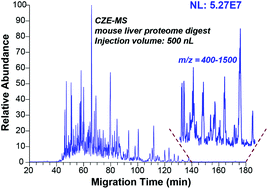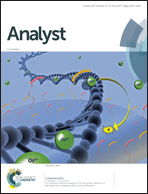Capillary zone electrophoresis–mass spectrometry with microliter-scale loading capacity, 140 min separation window and high peak capacity for bottom-up proteomics†
Abstract
Better peptide separation is required for bottom-up proteomics for further improving the proteome coverage. The two-dimensional liquid chromatography (2D-LC) systems only explore differences among peptides in their hydrophobicity (reversed-phase, RP) and charge (strong cation/anion exchange, SCX/SAX). Alternative separation techniques with different separation mechanisms are required to further improve the separation. Capillary zone electrophoresis (CZE) is an attractive alternative because it has high efficiency for separation of biomolecules and it separates analytes based on their size-to-charge ratios, complementary with LC. However, the low loading capacity and narrow separation window of CZE limit its wide application for large-scale proteomics. In this manuscript, we present an automated CZE–mass spectrometry (MS) system for solving those issues. The CZE–MS system can approach at least half-a-microliter loading capacity with good robustness and reproducibility, can routinely use over 12% of the available sample in the sample vial for analysis, and can generate a 140 min separation window and high peak capacity (∼380) for complex proteome analysis. The results represent the highest peak capacity and the widest separation window of CZE for peptide separation with a microliter-scale loading capacity. It is the first time that CZE–MS approaches both the microliter-scale loading capacity and over 2-hour separation window for analysis of complex samples. The automated CZE–MS system dramatically reduces the gap between CZE–MS and RPLC–MS in terms of loading capacity, separation window and peak capacity. It truly opens the door for large-scale bottom-up proteomics using CZE–MS.



 Please wait while we load your content...
Please wait while we load your content...